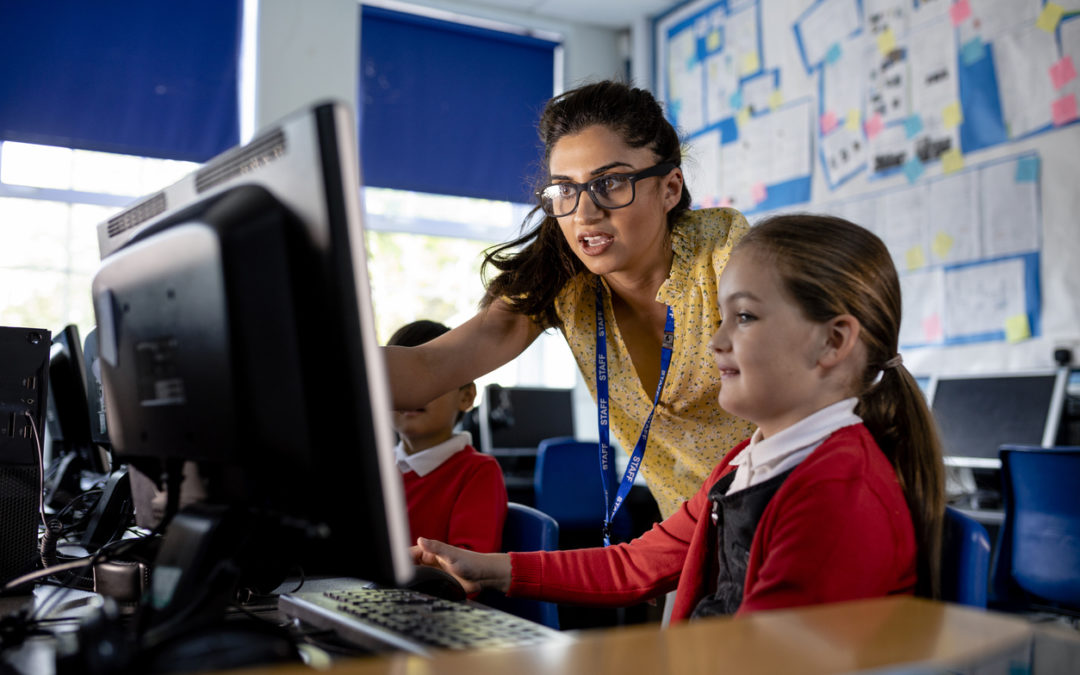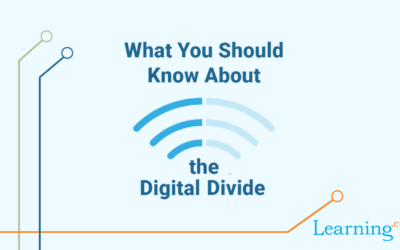The digital skills gap impacts Americans of all ages. If lacking basic digital skills, students will face challenges not only in school, but in the professional world as well. Students require digital skills to perform research and produce projects in school, as they navigate a digital world for community building and social interactions and as they enter the workforce.
Digital readiness is the broad phrase used to encompass the digital skills needed to use technology in useful, meaningful and innovative ways. Though “digital readiness” is broad and ambiguous, there are concrete digital skills that are foundational to this concept. In the remainder of this article, we will unpack and explore these.
Which Digital Skills Do Students Need?
The digital skills students need tend to fall under five basic categories. These include operation and application, or the ability to select and use appropriate tools for certain tasks and goals; inquiry and innovation, which includes the ability to collect, organize and visualize information using technology programs; problem solving & critical thinking, or the ability to use technology to uncover and apply solutions; online communication and research; and digital citizenship, or the ability to use technology in a safe and ethical way.
In the list below, we detail the digital skills students need in these five primary categories.
1. Keyboarding Effectively
Students should have proficiency in keyboarding to optimize expediency and fluency when using technology.
- Apply optimal posture and ergonomic strategies such as correct hand and body positions and smooth and rhythmic keystrokes.
- Demonstrate proper touch keyboarding techniques and correct hand placement.
- Gain proficiency, accuracy and speed in touch keyboarding.
- Identify, explore and understand the layout of common QWERTY keyboards.
- Use common hotkeys and shortcut key combinations.
2. Understanding Computer Fundamentals
Computer fundamentals include mastering basic computing functions and hardware. This important digital skill helps students identify and use basic technology resources to accomplish a variety of tasks.
- Demonstrate proficiency when using common technology devices, including basic skills such as:
- Turning on a computer and logging in.
- Using a mouse.
- Recognizing basic computer icons.
- Saving documents and changing file sizes.
- Understanding computer and network storage.
- Creating, organizing and manipulating shortcuts.
- Identifying and employing basic features of an operating system.
- Creating and maintaining files and folders.
- Practice responsible usage and care when using electronic devices and troubleshoot problems with hardware and software using available resources.
- Model the basic infrastructure of networks and how networks allow for online research, communication and collaboration.
- Make informed choices among technology systems, resources and services in a variety of contexts.
- Demonstrate an understanding of how changes in technology impact the workplace and society.
- Identify and assess the capabilities and limitations of emerging technologies.
- Utilize technology to facilitate personalized and interactive learning.
3. Utilizing Technology & Productivity Tools
Using technology, students should have the digital skills to enhance learning, increase productivity and promote creativity.
- Assess the appropriateness of software applications to accomplish a defined task.
- Collaborate in constructing technology-enhanced models, preparing publications and producing other creative works.
- Use a variety of electronic formats (e.g., web publishing, oral presentations, journals and multimedia presentations) to summarize and communicate results.
4. Understanding Spreadsheets & Databases
Students should have the digital skills to understand that spreadsheets, databases and other similar digital tools are used to collect, organize, process, analyze and visualize real-world data. They should have a basic understanding of using, creating and editing these documents.
5. Using Word Processing
Students should be able to use word processing software to translate information into organized, effective documents that serve specific purposes.
- Create, edit and publish documents that demonstrate effective formatting (e.g. font, color, orientation, alignment, margins, spacing) for specific audiences.
- Create documents for specific purposes including content for a web page, resumes, business letters and multi-page papers with citations for school assignments.
- Leverage intermediate features in word processing applications such as tabs, indents, headers and footers, end notes, bulleting and numbering and tables.
- Use a word processor as a tool to enhance learning, increase productivity and promote communication and collaboration.
- Strategize visual design to emphasize key information and improve readability with formatting features such as columns, tables and styles, as well as the use of images and other graphic elements.
- Proofread and edit writing using available resources including spell check, grammar and autocorrect, while also understanding the limitations of these tools.
- Collaborate with peers and leverage functionality like comments and track changes.
- Leverage a word processor as a part of the problem-solving process to construct technology-enhanced models, prepare publications and produce other creative works.
6. Creating Presentations
Students create linear and non-linear presentations tailored to specific audiences that present research, tell a story, or exchange ideas using slideshow software and applications.
- Evaluate for organization, content, formatting and appropriateness of citations to maximize accuracy and design.
- Implement a process to practice, polish and add notes to strengthen the delivery and dissemination of information.
- Apply basic design elements including font, color, alignment, white space and layouts, as well as develop templatized layouts, to improve slideshow content.
- Make strategic use of visual and audio elements, such as graphics, audio effects, transitions, animations and video components, to add interest and express meaning.
- Design presentations with specific audiences in mind.
- Use teacher developed guidelines to evaluate multimedia presentations for organization, content, design, presentation and appropriateness of citations.
7. Create Effective Multimedia
Another important skill is understanding, utilizing and creating multimedia. Students should be able to communicate ideas visually and graphically using appropriate digital tools and applications.
- Create and edit files in various formats, including audio, video, moving images, text and graphics.
- Demonstrate how the use of various techniques and effects (e.g., editing, music, color, rhetorical devices) can be used to convey meaning in media.
- Demonstrate an understanding of basic design principles and strategies to increase the effectiveness of a digital product as viewed by different audiences and in different contexts (print, web, screen and monitor).
- Create original works, responsibly repurpose and remix digital resources and incorporate various files into new creative multimedia works.
8. Create & Use Visual Mapping
Students should be able to use digital skills to plan and create visual digital products that express thoughts, illustrate complex processes and share stories in a sequential manner.
- Gather and organize information.
- Visually present information for specific audiences.
- Create, edit and publish thoughts and ideas visually.
- Brainstorm; capture ideas, understanding and information; and explore complex concepts visually.
9. Create & Use Spreadsheets Effectively
Another important digital skill students should have is the ability to create, read, utilize and edit spreadsheets effectively, as well as understanding the available functionalities of a spreadsheet.
- Identify and explain terms and concepts related to spreadsheets (e.g., cell, column, row, values, labels, chart graph).
- Use spreadsheet tools and features to facilitate the collection, analysis and presentation of information including:
- Text formatting features (e.g., merge cells, wrap text, font, color, alignment).
- Advanced formatting (e.g., reposition columns and rows add and name worksheets).
- Data entry (e.g., auto fill, import and export functionality).
- Various number formats (e.g., scientific notations, percentages, exponents).
- Mathematical symbols (e.g., + add, ‐ minus, *multiply, /divide, ^ exponents).
- Functions of a spreadsheet application (e.g., sort, filter, find).
- Computing methods and formulas (e.g., sums and averages).
- Create data visualizations for specific audiences and purposes by assessing the most appropriate type of chart to represent given data.
- Collect real-world data and analyze the results to draw conclusions, recognize patterns and relationships in the data and make predictions.
10. Use & Produce Databases
- Identify and navigate common examples of databases from everyday life (e.g., library catalogs, school records, contact directories and search directories).
- Use effective search strategies for locating and retrieving electronic information in common databases (e.g., using Boolean logic and filters).
- Plan, create, modify and edit fields and records in a database.
- Use the sort, filter and query tools to produce reports to share and analyze information.
11. Performing Computational Thinking
Students should have the digital skills to wield technology resources for problem solving, critical thinking and informed decision making.
- Demonstrate a disposition amenable to open-ended problem solving (e.g., perseverance, creativity, patience and adaptability).
- Understand that a problem can have many solutions and that solutions can be adapted or modified to solve similar problems using modeling, simulation, creating prototypes and by refining solutions after testing.
- Determine what is known and what needs to be known regarding a problem and develop a problem statement in order to solve a problem or complete a task.
- Identify complex, interdisciplinary and real-world problems that can be solved computationally.
- Demonstrate that solutions to complex problems require collaboration, interdisciplinary understanding and systems thinking.
- Decompose complex real-world problems into manageable subproblems that could integrate existing solutions or procedures.
- Create and interpret visual representations such as flowcharts and diagrams to organize data, find patterns, make predictions or test solutions.
- Collect data or identify relevant data sets, use digital tools to analyze them, and represent data in various ways to facilitate problem-solving and decision-making.
12. Understand & Use Algorithmic Thinking
- Use algorithmic thinking to identify algorithms in everyday life.
- Determine how algorithms can be used to accomplish tasks and solve problems.
- Understand how automation works and use algorithmic thinking to develop a sequence of steps to create and test automated solutions.
13. Understand Basic Coding Processes
Students plan the development of a computational artifact using basic coding skills that include reflection on and modification of the process as well as understanding key features, time and resource constraints, user needs and expectations.
- Define an algorithm as a sequence of defined steps or instructions to be followed and identify how algorithms relate to computer programming and allow for automation.
- Develop and execute an algorithm that includes sequencing, loops and conditionals to accomplish a task with or without a computing device.
- Systematically test algorithms to identify and correct errors, including those involving operators, conditionals, parallelism and repetition.
- Construct basic programs that include sequencing, events, loops, conditionals, functions and variables
- Evaluate existing technological functionalities and incorporate them into new designs.
- Abstract common features from a set of interrelated processes or complex phenomena and create modules and develop points of interaction that can apply to multiple situations and reduce complexity.
- Evaluate and refine a computational artifact multiple times to enhance its performance, reliability, usability and accessibility.
- Describe, justify and document computational processes and solutions using appropriate terminology consistent with the intended audience and purpose.
- Solicit and incorporate feedback from and provide constructive feedback to team members and other stakeholders.
- Include the unique perspectives of others and reflect on one’s own perspectives when designing and developing computational products.
14. Using the Internet Effectively, Safely, & Responsibility for Online Communication, Collaboration & Research
- Facilitate communication, research and collaboration with digital tools.
- Describe and practice “etiquette” when communicating and sharing information online.
- Compose, send and organize e-mail messages with and without attachments.
- Explain the differences among various search engines and how they rank results.
- Use search strategies to acquire and organize media and digital content through information sourcing.
- Evaluate resources for validity, accuracy, relevance and credibility.
- Analyze and explain how media and technology can be used to distort, exaggerate and misrepresent information.
- Recognize the ethical and legal implications of plagiarism of copyrighted materials.
- Use web 2.0 tools (e.g., online discussions, blogs and wikis) to gather information and publish digital media.
- Create, share and utilize collaborative workspaces, documents or other digital tools for asynchronous and synchronous collaboration with remote learners.
- Reflect on their responsibilities and rights as creators in the online spaces where they consume, create and share information.
15. Understand & Maximize Online Safety
- Understand how to be safe and make responsible and ethical decisions online and in a digital world.
- Recognize and protect against the potential risks and dangers associated with online communication and participation in online communities (e.g., discussion groups, blogs and social networking sites).
- Understand the importance of communicating and reporting inappropriate content and illegal activities in a digital society.
- Identify and understand the positive and negative effects of digital technologies and devices and how technology can impact all aspects of life and society.
- Recognize online threats to privacy and practice effective strategies to secure and protect personal data from data-collection technologies and malicious software.
- Manage online information and use strategies, like creating strong passwords, to keep it secure from online risks.
- Practice self-reflection and consider how sharing online can impact themselves and others.
- Understand the role an online identity plays and the permanence of choices and decisions when interacting online and cultivate a positive digital identity.
- Identify cyberbullying and describe strategies to deal with such a situation.
Final Thoughts
The list of skills students should have is extensive–and regularly grows based on new technologies and digital advances. Teachers and administrators can help teach these essential digital skills through programs such as Learning.com’s EasyTech program. Learn more about EasyTech and its comprehensive digital literacy program by clicking the button below.

Learning.com Team
Staff Writers
Founded in 1999, Learning.com provides educators with solutions to prepare their students with critical digital skills. Our web-based curriculum for grades K-12 engages students as they learn keyboarding, online safety, applied productivity tools, computational thinking, coding and more.
Further Reading
Online Safety Definition & Basics
In today’s digital age where students are more connected than ever, online safety has become an important part of digital literacy education. With...
A Crash Course in Digital Footprints: Teaching K-12 Students the Importance of Online Contributions & Interactions
In today's interconnected world, every click, post and search we make online contributes to our digital footprint, a complex and often permanent...
Digital Divide Statistics: The 4 Digital Divides Affecting Students
Flashback to the mid-1990s: Vanilla Ice released “Ice Ice Baby;” Ross and Rachel were on a break; and Google, Amazon, and Hotmail (RIP) graced the...




